"Jesus can see everything I do... and he's going to beat me brainless." – Bubby |
"Fuck you, God! Strike me down if you dare, you tyrant, you non-existent fraud!" – The Scientist |
If you're someone who at times finds themselves offended by the content of a movie, you might want to browse this small selection from IMDb plot keywords for Rolf de Heer's 1993 Bad Boy Bubby before sitting down for a family movie night:
- Female Nudity
- Male Frontal Nudity
- Groping
- Mentally Handicapped
- Dead Cat
- Mother Son Incest
- Animal Cruelty
- Anal Rape
- Sex
- Smothered to Death
- Blow Up Doll
- Masturbation Scene
- Matricide
And there's no mention there of the sexual encounter with a horny Salvation Army singer, a sequence where the adult lead character wets himself rather than defy his mother, and the angry insults thrown at God in an open rejection of religion. Shall I start the disc now?
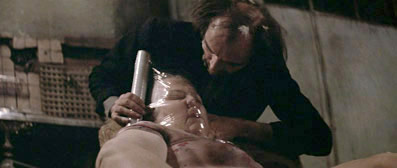
It's interesting, though perhaps not all that surprising, that most people I've read that little list to seemed more concerned about the animal cruelty than the anal rape, and those who've seen it tend to get a lot more het up over the cat that's tied to a chair and wrapped in cling film than the dismembered cockroach. Oops, just lost a few more potential viewers there. I can assure you that all of these elements have purpose here, but would imagine that cuts little ice with those for whom that little collection of keywords suggests a crude attempt to simply be controversial and provoke a reaction. It certainly struck a nerve back on its UK release, when TV's Mr. Movies, Barry Norman, picked it as one of his ten worst films of the year. Not so long ago, however, celebrated director Mike Leigh selected it as one half of his Double Take on the UK's Film Four channel and provided a most enthusiastic introduction to its screening. Now come on, which of these two are you more likely to heed?
If you're apprehensively game but hoping to be gently eased into the tricky stuff, then it's best to know up front that a good third of the above taboos are broken in the film's first third. The Bubby of the title (and the original title was simply that, 'Bubby') is a bedraggled and seemingly backward man in his early thirties who lives with his mother (known as Mam) in a dark, dilapidated room devoid of windows or any form of electronic communication, in which he has been effectively imprisoned since birth. A brusque and domineering woman, his mother feeds and cleans her son and uses him for sexual gratification, but commands him with verbal and physical threats and a fear of a world beyond the room that she has convinced him is deadly, her gas mask offering the only protection against its poisonous air. When Bubby questions how a cat could have been brought in from outside, he is starkly introduced to the concept of suffocation, a lesson he passes on to the unfortunate animal. But when the father he has never met returns and picks up where he left of with Mam, Bubby suffers confusion and violent rejection, and one night murders both parents and ventures into the world outside for the first time.
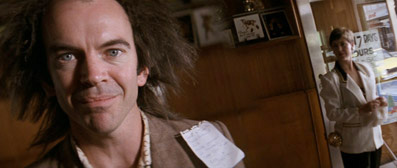
If this set-up sounds a little creepy then you don't know the half of it. The room in which this all takes place is like something from a bad dream by David Lynch, a grey, run-down and oppressive cell devoid of sunlight and any real sense of hope. Bubby himself is very much a product of this environment and his mother's conditioning, his seemingly retarded state the result of a lack of communication with others, his only means of expression being repetition and mimicry. On his departure from the room, it's this that is to prove both his biggest handicap and his greatest asset, as what insults and outrages some is more positively misinterpreted and even embraced for its eccentricity by others.
This leads to a process of very direct cause and effect that shapes Bubby's subsequent development, as actions and words absorbed from one life experience are applied to the next with wildly varying results. Thus the abuse yelled at him by a roudy vehicle occupants on his first brief emergence from his prison are recalled when he finds himself in their position, as a passenger in a car faced with a human obstruction, but the traffic policeman he directs the insults at responds angrily and thumps him. This also proves a trigger for subsequent events, as not only does the attack result in his rescue by a sympathetic rock band, with whom he finds a temporary home and unexpected popularity as a front man, but he also later recycles the cop's actions to rob a gas station attendant, an assault only undertaken in the first place because he takes a flip comment made by the band about bringing back some money at face value. Elsewhere his mimicking of Pop's groping of Mam and his unshakeable oedipal complex get him a sound kicking and land him in jail, but it also secures him a night of passion with the aforementioned Salvation Army singer and kick-starts a relationship with buxom nurse Angel, who just may prove to be the salvation suggested by her name.
For those willing to go with the taboo busting, the film proves a surprising and sometimes spellbinding journey through the fringes of modern Australian society, passing sly comment on our own learning process and the manner in which attitudes and even prejudices are formed. Bubby is effectively a child in an adult's body, an innocent at large in a world he does not understand and that misreads his words and actions, which has prompted some to draw parallels between this film and Hal Ashby's celebrated Being There and even Scott Hicks' later international hit Shine. But while you could safely take your grandmother to see either of those, de Heer's film walks a decidedly more difficult path, the director's refusal to self-censor making even the dialogue a potential flashpoint for negative reaction.
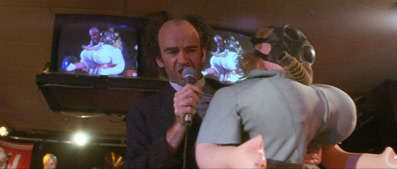
But as I said, if you're up for the challenge then the rewards are there aplenty, not least in Nicholas Hope's extraordinary central performance and the sterling work of a seemingly fearless support cast. Individual sequences are striking and really lodge in the memory: the skewed viewpoint as Bubby's world-in-a-room starts to collapse around him (itself a glorious happy accident, the result of a lens not being properly mounted on the camera); his first, revelatory view of the city lights and the angelic choir soundtrack that turns out to be a Salvation Army practice session (a trick borrow from Mel Brooks and Woody Allen, but impeccably done); Bubby's Frankenstein monster-like fascination with a garage violin performance; his total immersion in the rhythm of a printing press, which we are encouraged to share when the screen blackens in sync with his closing eyes; the mesmerising sequence in which he is driven frantic by the sound of bagpipes, music he subsequently escapes to as he is sexually abused by another prisoner; the jaw-dropping drift from close-up to extreme wide shot as a scientist delivers one of the most exquisitely written anti-religious monologues ever committed to film (for transcript click here); Bubby's first spell as the front man of a rock band (his later similarity to Nick Cave is, we are assured by the director, completely co-incidental). And this is just a random pick from so many. The film has even given cult filmdom a couple of favourite phrases in "Christ, kid, you're a weirdo" and "Well if that's all there is...we're stuffed!"
Visually and aurally the film is not quite like any other, thanks to some bold but almost invisible experimentation on de Heer's part. Despite Ian Jones' front-of-film DoP credit (he was the film's sole camera operator), a total of 32 cinematographers worked on the film, a different one for each location that Bubby visits, which gives each experience its own visual identity. In a similarly subjective vein, the sound was largely recorded through two small microphones located behind lead actor Nicholas Hope's ears and hidden by his ragged wig, creating a soundtrack that is heard almost exclusively from his viewpoint. The trick is that neither technique draws attention to itself, and the effect is thus considerably more subtle than the post-modernist hammer blows delivered by more recent post-production digital game-playing.
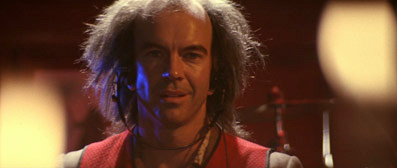
Watching Bad Boy Bubby again after a gap of several years, particularly in its correct aspect ratio and with the picture and sound quality as good as it is here, was an almost revelatory experience. I remember enjoying and admiring it on the first viewing (which was on video tape and framed 4:3 if the memory serves me well) and being pleased to see that it had weathered so well on the second a few years later, but I genuinely don't remember it being this good. Yes, there are uncomfortable moments even for the more adventurous audience, and yes, the ending will be seen as some as a compromise (although given the oedipal nature of Bubby's relationship with Angel, it's not quite the conformist conclusion that some have suggested), but in all other respects this is a genuinely remarkable work, one that manages to be disturbing and even shocking and yet also funny, tender, insightful and moving, and a fine example of outsider cinema at its most cinematically and dramatically satisfying.
In an unusual move for Eureka – or should that be a first? – Bad Boy Bubby has been released as a three-disc set presenting the film on three different formats: Blu-ray, DVD and a digital copy for playback on computers and portable devices.
I'll start by pointing out that this was a low budget film even by 1990s Australian independent standards (the estimated budget was some way under a million dollars) and that the early sequences, where the light is low and the colour scheme pared down, present a challenge to any digital transfer. A significant portion of the film also takes place at night, adding the difficulty of retaining shadow information whilst keeping the black levels from drifting. Fortunately the transfer here rises to every challenge it's set, getting the contrast right and losing none of the detail, even in the dimmer sequences, while the colours appear true to the original intentions and really pop when they are required to. The deliberately drab look of the first third means that the difference between the DVD and Blu-ray transfers is not immediately obvious, but a side-by-side freeze frame on a wide, daytime roadway exterior from later in the film reveals a noticeably higher level of detail on the Blu-ray, with writing on road signs and hoardings that appears blurred and indistinct on the DVD transfer easily legible on the Blu-ray. The framing is the original 2.35:1 and is anamorphically enhanced on the DVD.
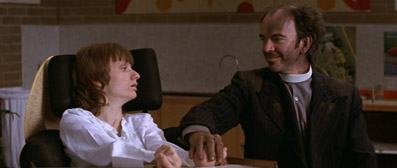
The digital version is on disc 3 and consists of an MP4 file for Mac users and a whole blather of files for Windows users, including a couple of installers. I'm assuming that this version of the film can be transferred to the portable device of your choice for mobile viewing – certainly I had no problems getting it across to my iPhone via iTunes on my Mac. The scope picture sits within a 4:3 frame, presumably for maximum device compatibility.
As mentioned above, the method of recording sound was a little unusual, with the two binaural microphones worn by lead actor Nicholas Hope providing the key elements of the soundtrack, and in some scenes all of it. This makes for a very subjective sound mix, where the volume and clarity of dialogue and sound effects can vary depending on which direction Hope is looking at the time. This is no compromise, however, and the clarity and range of all available tracks itself is very impressive. On the DVD the choice is between Dolby 5.1 surround and Dolby 2.0 stereo – the stereo wins on volume, but the surround has more finesse. On the Blu-ray you can select between Dolby stereo 2.0, Dolby TrueHD 5.1 and DTS Master Audio 5.1. Without the requisite HD amp I can't testify to the finer points of these tracks, but even through a regular DTS amp there's a detectable step up from the DVD, but the DTS HD Master Audio track provides a noticeable jump in volume and punch. In line with the subjective approach, the volume can vary a bit, sometimes quite dramatically – on the DTS track in particular there's a substantial loudness leap during the musical performances, one that will likely give anyone in the local vicinity a jolt if you have the volume cranked up as I did.
But there's more. Also included is a binaural track designed specifically for headphone listening, designed to, in the words of the menu, "put you inside Bubby's head." Now I'm guessing this will work best with top-of-the-line noise canceling headphones, where you can shut out everything else and hear the sound at its crispest. Even on my Koss portables, though, the more pronounced separation and inclusive nature of the track is easy to appreciate.
Commentary with director Rolf de Heer and actor Nicholas Hope
Good commentaries are worth their weight in fine cut diamonds, and this is just such a jewel. Soft spoken and devoid of a the sort of "I love this..." self-congratulation that blights so many recent mainstream commentaries, this is a splendid accompaniment to the film, packed to the gills with background information, recollections of the filming and intriguing trivia. The density of information delivered can be gauged by the five pages of notes I scribbled as I listened, but if I had to pick a few favourite bits I'd go with: the background stories about the two cats that perish in the film; the set that grows in size as Bubby's world expands, the news that the song from which the present title was drawn was improvised by one of the musician actors; de Heer throwing away the deleted scenes because in those pre-DVD days he saw no reason to hang on to them; the revelation (no pun intended) that the toughest thing in the whole film for Hope, a practicing Catholic, was to denounce God and invite divine retribution; and the unnamed actor who, after watching Bad Boy Bubby, passed on the chance of a part in a later de Heer movie because "I don't want to spend three months in the jungle with a madman." And that's just a sprinkling. The only brief pause occurs when the two men start getting involved in what they are watching, something they chastise themselves for and instantly put right.
Christ Kid, You're a Weirdo – Interview with director Rolf de Heer (23:57)
An enjoyable and informative chat with director de Heer, who covers the long writing process (it was ten years from conception to completed script), getting the film made, the reason for using thirty-two cinematographers, and reaction to the finished product, plus a whole lot more. Inevitably there's some crossover with the commentary track, but much of that is covered in more detail here.
Theatrical Trailer (1:50)
A surprisingly good sell of a film that must have given PR people a few headaches.
Booklet
A small booklet containing reproductions of letters sent by director Rolf de Heer and actress Claire Benito sent to the Italian Society for the Prevention of Cruelty to Animals and the Australian Embassy in Rome to counter false stories about the treatment of the cats in the film.
I can pretty much guarantee that this is a film that will seriously divide audiences, but as director de Heer says in the interview on this very disc, those who do like the film tend to do so with a passion, and I'm certainly guilty here. This is terrific outsider cinema and has been handsomely treated here, with a damned good DVD transfer that looks even better on Blu-ray, a digital copy included for those who watch on the move, and quality audio options that do justice to the film's unique soundtrack. A splendid commentary track is the icing on the cake. Highly recommended.
|